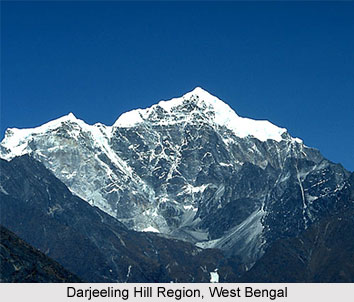Indian mountains of eastern region consist of the different mountain ranges and hills located in the states of Eastern India like West Bengal, Bihar, Jharkhand and Orissa.
Mountains of West Bengal
Darjeeling Himalaya Hill regions, Falut, Poobong, Tonglu, Sandakfu, Singalila Ridge are the innumerable mountains and peaks which are present in the state of West Bengal. The Himalayan region comprises Singalila Range which has a height of 3636 meters, Darjeeling-Kurseong range which measures 2600 metres, Chola range which measure 1704 metres and Buxa-Jayanti range which measure about 1400 metres. Other hills involve Ayodhya Hills in Purulia that measure 855 metres, Biharinath in Bankura which measures 451 metres, Susunia which measure 448 metres and is located in Bankura. The hillocks are Mukutmanipur which is 200 metres in length, Mama Bhagne Hillock which has a height of 105 metres and hillock of Eastern Kolkata which has a height of 20 metres. Other hills are Tonglu hills, Tiger Hills, Ghum Hills, Deolo Hills, Gorbabu Hills, Durpin Hills, etc.
Mountains of Bihar
Bihar consists of hills like Rajgir Hills, Barabar Hills, Kaimur Range which is about 483 kms in length, Brahmayoni Hills, Pretshila Hills and Ramshila Hills.
 Mountains of Jharkhand
Mountains of Jharkhand
Mountains of Jharkhand are Parasnath Hills near Gomoh which is 3,544 feet, Dubaur in Kodarma which measures 1,970 feet, Singarsi Peak in Sahibganj which measures 1,503 feet, Kotwar Pahar in Kalikapur which is about 1,503 feet, Lapsa Baru in Chaibasa which measures 1,044 feet, Trikut Parvat in Jamtara which is 1,033 feet and Sideshar in Mushabani which measures 817 feet are the various mountains located in Jharkhand.
Mountains of Orissa
Orissa boasts of several mountains like Singaraja Mountain in Saroda which measures 4,631 feet, Nimgiri near Balangir, which is 4,002 feet, Megasini in Jajpur which measures 3,819 feet, Ganpati Pahar near Jajpur which measures 3,655 feet, Chata Danda in Jajpur which measures 3,635 feet, Amjhori Hills near Jajpur which measure 3,550 feet, Mankarnacha near Talcher which measures 3,374 feet, Deva Giri near Phulbani which is about 3,165 feet, Balia Pahar near Bolanikhodan which measures 3,117 feet, Mahendra Giri near Sorada which measure 2,898 feet, Betjharana Parbat in Bhadrakh which measure about 2,717 feet, Raegara Hills in Asika which measure 2,137 feet, Thakurani Pahar in Bada which measure 2,066 feet, Goaldei in Buguda which measure 1,935 feet, Banspani Pahar in Barabil which is 1,829 feet, Bola in Jajpur which is 1,667 feet and Malayagiri in Talcher which measure 1,627 feet.















